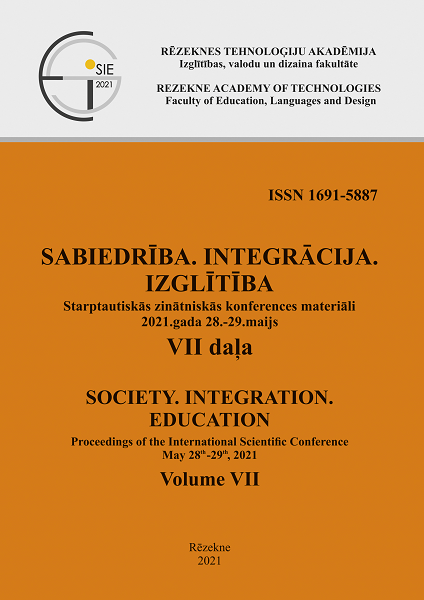DEVELOPMENT AND INITIAL VALIDATION OF THE STRESS SYMPTOMS SCALE
DOI:
https://doi.org/10.17770/sie2021vol7.6426Keywords:
criterion validity, psychometric properties, reliability, scale development, stress symptomsAbstract
The aim of this study is to develop and to perform an initial validation of the Latvian and Russian version of the Stress Symptoms Scale. A preliminary version of the scale (k = 65) were administrated to the test development sample as an on-line survey. Additionally participants (N = 272, aged from 19 to 68, M = 37.2, SD = 11.6, 13% male) filled in the Latvian or Russian version of the Perceived Stress Scale-4 (PSS-4), and responded using 10-point scale on two criterion questions about the frequency and intensity of the experienced stress during the last two weeks. Information of their age, gender and education level were collected as well. Based on performed psychometric analysis a final version of the SSS was developed. It consists of 56 items, which can be combined into four scales: 1) Impaired functioning of cognitive processes; 2) Psychological symptoms of stress; 3) Physical symptoms of stress; 4) Emotional symptoms of stress. Based on Exploratory and Confirmatory factor analysis a four-factor solution is preferable. Both versions (LV and RUS) of the scale show excellent internal consistency (Cronbach’s alpha ranged from .92 to .98). Concurrent validity of the SSS was approved by high correlation with criterion-measures. Both versions of the SSS show acceptable to excellent psychometric properties and can be used by psychologists and other mental health professional for the better understanding of individual’s stress reactions and for a reliable evaluation of stress level based on the set of stress symptoms.
References
Aro, S. (1981). Stress, morbidity, and health-related behaviour. A five-year follow-up study among metal industry employees. Scandinavian journal of social medicine. Supplement, 25, 1-130. PMID: 6951286. Retrieved from https://www.jstor.org/stable/45200077
Bourne, E. J. (2015). The anxiety and phobia workbook. Sixth edition. Oakland, CA: New Harbinger Publications, Inc.
Jones, F., & Bright, J. (2001). In F. Jones, J. Bright (Eds.), Stress: Myth, theory and research. Prentice Hall/Pearson Education.
Cohen, S. (1996). Psychological stress, immunity, and upper respiratory infections, Current Directions in Psychological Science, 5(3), 86-89. https://doi.org/10.1111/1467-8721.ep10772808
Cohen, S., Kamarck, T., & Mermelstein, R. (1983). A global measure of perceived stress. Journal of Health and Social Behavior, 2, 385-396. DOI: https://doi.org/10.2307/2136404
Cohen, S., & Williamson, G. (1988). Perceived stress in a probability sample of the United States. In S. Spacapam & S. Oskamp (Eds.), The social psychology of health: Claremont Symposium on applied social psychology. Newbury Park, CA: Sage.
Elkin, A. (1999). Stress Management for Dummies. New York, NY: Wiley Publishing, Inc.
Evans, G. W., & Johnson, D. (2000). Stress and open-office noise. Journal of Applied Psychology, 85(5), 779–783. DOI: https://doi.org/10.1037/0021-9010.85.5.779
Holmes, T. H., & Rahe, R. H. (1967). The Social Readjustment Rating Scale. Journal of Psychosomatic Research, 11(2), 213–218. DOI: https://doi.org/10.1016/0022-3999(67)90010-4
Hu, L. & Bentler, P. M. (1999). Cutoff criteria for fit indexes in covariance structure analysis: Conventional criteria versus new alternatives. Structural Equation Modeling, 6, 1–55. DOI: https://doi.org/10.1080/10705519909540118
Koh, K. B. (2018). Stress and Somatic Symptoms. Biopsychosociospiritual Perspectives. Cham, Switzerland: Springer Nature Switzerland AG. https://doi.org/10.1007/978-3-030-02783-4
Koh, K. B., Park, J. K., Kim, C. H., & Cho, S. (2001). Development of the Stress Response Inventory and Its Application in Clinical Practice. Psychosomatic Medicine, 63(4), 668–678. DOI:10.1097/00006842-200107000-00020
Lazarus, R.S. (1966). Psychological stress and the coping process. New York: McGrow-Hill.
Lazarus, R. S. (1976). Patterns of adjustment. New York: McGraw-Hill.
Levenstein, S., Prantera, C., Varvo, V., Scribano, M. L., Berto, E., Luzi, C., & Andreoli, A. (1993). Development of the perceived stress questionnaire: A new tool for psychosomatic research. Journal of Psychosomatic Research, 37(1), 19 -32. DOI: 10.1016/0022-3999(93)90120-5
Marsh, H. W., Hau, K. & Wen, Z. (2004). In search of golden rules: Comment on hypothesis-testing approaches to setting cutoff values for fit indexes and dangers in overgeneralizing Hu and Bentler’s findings. Structural Equation Modeling, 11, 320–341. DOI: 10.1207/s15328007sem1103_2
Matheny, K. B. & McCarthy, C. J. (2000). Write Your Own Prescription for Stress. Oakland, CA: New Harbinger Publications, Inc
Ogden, J. (2004). Stress and illness. In Copyright © Jane Ogden 2004 (Ed), Health Psychology: A textbook 3rd edition (251-259). Open University Press McGraw-Hill: New York
O’Leary, A. (1990). Stress, emotion, and human immune function. Psychological Bulletin, 108, 363-382. Pieejams: https://psycnet.apa.org/buy/1991-07331-001
Raščevska, M. (2005). Psiholoģisko testu un aptauju konstruēšana un adaptācija. Rīga: RaKA.
Rosseel, Y. (2012). lavaan: An R Package for Structural Equation Modeling. Journal of Statistical Software, 48(2), 1-36. DOI: 10.18637/jss.v048.i02
Selje, H. (2012). Mana mūža stress. Rīga, apgāds Jumava.
Spielberger, C.D., Reiheiser, F.C., Reiheiser, J.E. & Vagg, P.R. (2000). Measuring stress in workplace: The Job Stress Survey. In D.T. Kenny, J.C. Carlson, E.J. McGuigan & J.L. Shepard (Eds), Stress and Health: research and Clinical Applications (397 – 409). Amsterdam, The Netherlands: Harwood Academic publishers.
Sandi, C. (2013). Stress and cognition. WIREs Cognitive Science, 4(3), 245-261. DOI: https://doi.org/10.1002/wcs.1222
Scott, S. B., Graham-Engeland, J. E., Engeland, C. G., Smyth, J. M., Almeida, D. M., Katz, M. J., Lipton, R. B., Mogle, J. A., Munoz, E., Ram, N., & Sliwinski, M. J. (2015). The Effects of Stress on Cognitive Aging, Physiology and Emotion (ESCAPE) Project. BMC psychiatry, 15, 146. DOI: https://doi.org/10.1186/s12888-015-0497-7
The American Institute of Stress. (2020a). 50 Common Signs and Symptoms of Stress. Retrieved from https://www.stress.org/stress-effects
The American Institute of Stress. (2020b). What is Stress? Retrieved from https://www.stress.org/daily-life/
Quick, J. C., Quick, J.D., Nelson, D. L., & Hurrell, J. J. (2001). Preventive stress management in organizations. Washington, DC: American Psychological Association.
Velden, P. G., Kleber, R. J., Grievink, L., & Yzermans, J. C. (2010). Confrontations with aggression and mental health problems in police officers: The role of organizational stressors, life-events and previous mental health problems. Psychological Trauma: Theory, Research, Practice, and Policy, 2(2), 135-144. DOI: 10.1037/a0019158






